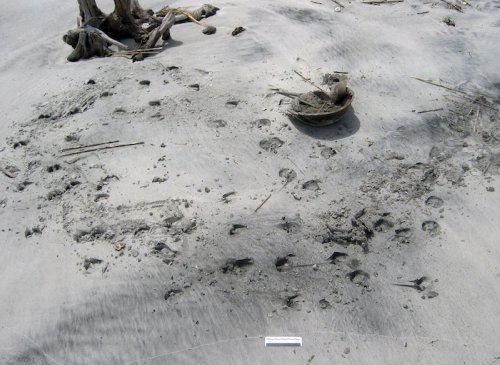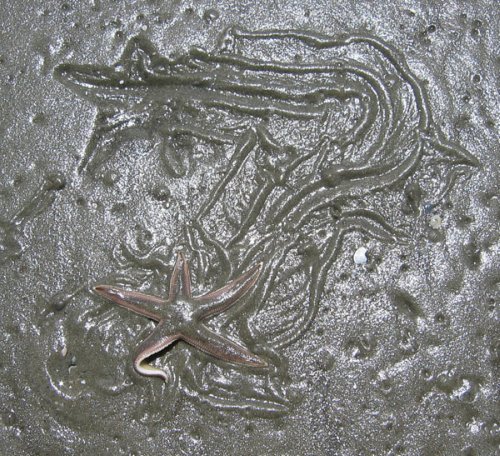by Anthony Martin (Atlanta Science Tavern Contributor)
“I don’t do humans!” This declarative statement, uttered by actor Jim Carrey in the movie Ace Ventura: Pet Detective (1994), is also my usual response to anyone who asks how much of my research in ichnology (the study of plant and animal traces) deals with humans. Sure enough, nearly all of my studies are of the tracks, burrows, trails, nests, toothmarks, feces, and other sign left by plants and non-human animals via their behaviors. Moreover, as a paleontologist, I also compare these modern traces to fossilized traces in the geologic record. Through such methods, I am applying a basic principle of geology, uniformitarianism, which has been followed by geologists and paleontologists for the past 200 years, and is often defined by the pithy phrase, “the present is the key to the past.” More elaborately, its tenets are that the modern processes we observe today – such as flowing water, weathering, erosion, volcanic eruptions, earthquakes, natural selection, and ecological change – also operated during the pre-human past.
Notice I said “pre-human past,” revealing both my biological and chronological biases. This perspective is also shared by most of my colleagues, as only a few ichnologists study behaviors of modern humans and the traces of these behaviors. This is more the realm of anthropologists, psychologists, historians, or forensic scientists (the last of these all too often depicted as glamorous detectives in lurid TV shows). In reality, the majority of ichnologists ignore humans, and more often use their observations of modern non-human traces as guides for traveling back in time to interpret the products of behavior from earth history. This is how we can interpret when (and why) a trilobite stopped and changed its direction while burrowing along a Paleozoic seafloor more than 400 million years ago. This is how we figure out what a dinosaur was eating on a given day during the Mesozoic Era, and that dung beetles were living with those dinosaurs, making use of the digested part of that dinosaur’s meal. This is how we identify the size and species of fish that swam along a lake bottom more than 50 million years ago, despite it having left only marks from its fins and mouth. Given nearly ten million species of modern life-forms and their behaviors to consider, four billion years of life history, and innumerable trace fossils that resulted from that life, why should we waste our time being anthropocentric, or otherwise let ourselves be distracted by just our species in the here and now?
Yet in my study of modern traces, a misgiving haunts me as I otherwise blissfully follow the tracks of an alligator, measure the width of a ghost-crab burrow, or sketch the drillholes left by a woodpecker in a tree trunk. My apprehension is best communicated by the metaphor of a broken mirror. Such a mirror may reasonably reflect the truth in front of it, but also may be fractured enough that it obscures important details, rendering imperfect portraits of its subjects and potentially misleading its observers. In my world, the “cracks” in this mirror are the altered ecosystems and changed behaviors of other organisms, all of which have been and will continue to be affected by human behavior. So it turns out that no matter where I go to study the traces of modern plants and animals, I can’t ignore humans after all.

Behold! A beautiful beach at low tide on St. Catherines Island (Georgia), an island untouched by the hand of man. Well, except for all of the Native American shellrings, Spanish mission, logging, agriculture, slave dwellings, roads, and feral animals. Other than that, it’s untouched.
For example, the word “pristine,” applied so blithely to describe nearly all of the Georgia barrier islands, is about as appropriate as calling Mick Jaggar “virginal.” Starting with the end of the Pleistocene Epoch, about 12,000 years ago, the first humans in North America may have hastened the extinctions of mammoths, giant ground sloths, and other large mammals that lived near or on what is now the Georgia coast. Native Americans who lived on the Georgia islands, beginning about 5,000 years ago, used fire and agriculture to modify island landscapes, while also making settlements and building large shell rings. The arrival of Europeans on the Georgia coast in the 16th century then accelerated ecological change in the islands. With European colonization, more large animal species were extirpated from the southeast, including cougars and red wolves. New species of plants and animals were introduced, including feral hogs, which still inflict ecological havoc on island ecosystems today. Europeans and Americans clear-cut maritime forests for ship-building, and enslaved large numbers of people from western Africa, who filled in salt marshes and cultivated vast fields of rice and other non-native crops. Fresh water, formerly abundant in island interiors in alligator-made ponds and fed by artesian wells, became more scarce as alligators were overhunted, their habitats erased, and groundwater resources over-tapped. Europeans and Americans created new islands from ship ballast, which included soils holding seeds of more invasive species. Most recently, climate change – the largest and most over-arching human trace of all – has resulted in rapid sea-level rise during the past 200 years, quickening coastal erosion and salt-water intrusion of maritime forests. In summary, when someone describes the Georgia barrier islands as “pristine,” it brings to mind another movie quotation, but this one from the character of Inigo Montoya in The Princess Bride: “You keep using that word. I do not think it means what you think it means.”

An ecological interaction on St. Catherines Island beach told by traces, and one that would not have happened there before the 16th century: a feral hog (Sus crofa), its species originally native to Europe and a land-dwelling animals, scavenged a native and sea-dwelling horseshoe crab (Limulus polyphemus) after the latter was stranded by a high tide. So how does an ichnologist apply this weirdness to the fossil record?
So does such a startling and potentially depressing realization disprove all of uniformitarianism, reduce all of our studies of modern traces to meaninglessness, and mock those genuinely gasp-inducing moments of loveliness we experience on the Georgia barrier islands? Of course not. Just like cracks in a mirror, or the faults we might see in our loved ones, we ichnologists just accept that this legacy is part of our changed world, overlain as it is by the traces of human behavior. In this sense, the environments and traces we study and appreciate today are palimpsests, manuscripts being overwritten by a mixture of traces by modern and exotic species, humans included. This knowledge does not make our science any less significant or fun, and certainly should not cause anyone else to huddle indoors and use all of their spare time to correct people who are wrong on the Internet. Instead, it should inspire you to go outside, find some traces, and be awed at what these traces tell you about their makers and their evolutionary heritage. Give thanks that you can see them here and now, the most recent of marks left by life in our 4.5 billion-year-old planet. And that’s a beautiful practice, no matter how flawed your mirror might be.

A trail with its tracemaker, always a welcome sight on a Georgia beach, but this one was particularly striking. The tracemaker is a lined sea star (Luida clathrata), and it was making a trail on the exposed sandflat as it sought the comfort of sea water. Yes, I threw it back into the water after taking the photo, with the hope I would see its traces again some day.
Anthony (Tony) Martin is an ichnologist, paleontologist, and geologist, who teaches in the Department of Environmental Studies at Emory University. His most recent book is Life Traces of the Georgia Coast: Revealing the Unseen Lives of Plants and Animals (Indiana University Press), and he blogs regularly at his Web site, Life Traces of the Georgia Coast.
